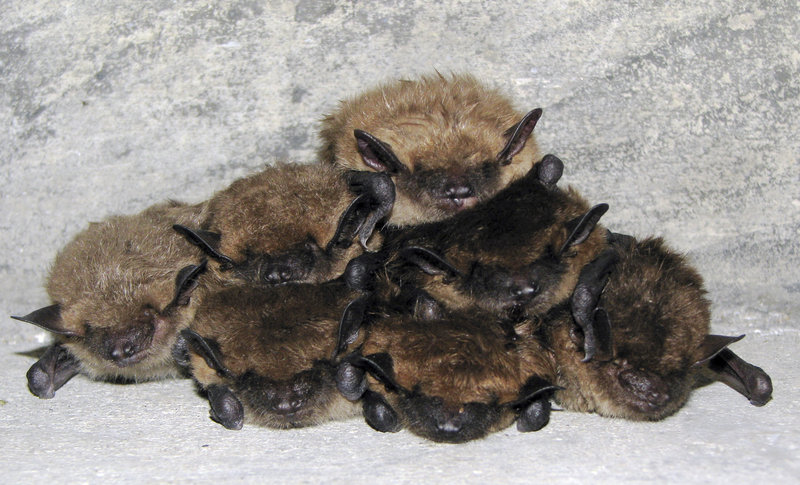CONCORD, N.H. – Biologist Susi von Oettingen walked into the dark World War II-era military bunker and took out her flashlight. Among the old pipes, wires and machinery, she saw some bats hanging from cracks in the cement walls and ceiling.
It was an unusual place for the bats to hibernate, different from a mine or cave. But something else was different, too: None of them had white-nose syndrome, a fungus that’s killing bats across the country.
The group of bats found last winter in the New Hampshire bunker was small, said von Oettingen, an endangered species biologist for the U.S. Fish and Wildlife Service. But two of the three species discovered there — the northern long-eared bat and the little brown bat — have been dying off from the disease.
Starting as early as next month, von Oettingen will be part of a group of state and federal biologists monitoring that bunker and a few others in the state. They’ll study temperature and humidity levels and put up footholds for the bats, hoping to attract more and figure out if there’s a way to control white-nose syndrome, first discovered near Albany, N.Y., in 2006.
The disease, which appears to affect bats mostly during winter hibernation, has killed more than a million bats in the Northeast and has spread to at least 11 states, as far west as Oklahoma, and parts of Canada. Some caves on federal lands were closed to people this year to prevent them from spreading the disease on their clothing.
Because the bunkers would be controlled, artificial settings, biologists also might be able to experiment with different treatments for bats with the disease, without worrying about how a spray or drug might affect other organisms.
“This is one of the most promising things I’ve heard,” said Nina Fascione, executive director of Bat Conservation International, an Austin, Texas-based group that focuses on research initiatives involving bats and their ecosystems.
One of the challenges is encouraging enough bats to use the bunkers, von Oettingen said. “They move around on the landscape, so it may be that they will naturally colonize it, or we may bring some in,” she said.
Von Oettingen said New Hampshire plans to reach out to neighboring states to examine their bunkers. Some, such as the one she visited, are on state park land. Others are part of the National Wildlife Refuge System.
“There’s tons of bunkers of all different kinds out there on the landscape,” from World War II, the Cold War-era, and afterward, she said. “Now the question is, do some of these have bats? And so far, we haven’t found any more.”
Bats hang out in all sorts of manmade structures, but the idea of monitoring them for white-nose syndrome in an artificial setting is relatively new. In Tennessee, the Nature Conservancy has proposed building a large dome-shaped cave, “like a giant upside-down underground swimming pool,” said Cory Holliday, the program’s cave and karst director. “You can apply whatever control you wanted in there and you wouldn’t be affecting a natural ecosystem.”
Tennessee has about 15 species of bats, roughly half of which are potentially susceptible to white-nose syndrome. At least several hundred bats were found with symptoms last year.
In October, the U.S. Fish and Wildlife Service came out with a plan to investigate the cause of disease, in which a white fungus develops around bat muzzles, ears and wing membranes, and find ways to manage it.
Biologists say fewer bats, which eat insects, could lead to increased numbers of pests, resulting in harm to agriculture and forests. It is anticipated that white-nose syndrome will continue to spread, partly because the fungus can be carried on humans’ clothing.
In New Hampshire alone, surveys last year showed that the state lost over half of its hibernating bats.
“They’re dead. They’re gone. They’re not here,” said Emily Brunkhurst, a wildlife biologist for the New Hampshire Fish and Game Department.
“The thing about white-nose is it is an unprecedented disease,” Brunkhurst said. “We have never seen a disease in wildlife that affects so many species and is so rapidly fatal and spread so incredibly rapidly.”
Send questions/comments to the editors.



Success. Please wait for the page to reload. If the page does not reload within 5 seconds, please refresh the page.
Enter your email and password to access comments.
Hi, to comment on stories you must . This profile is in addition to your subscription and website login.
Already have a commenting profile? .
Invalid username/password.
Please check your email to confirm and complete your registration.
Only subscribers are eligible to post comments. Please subscribe or login first for digital access. Here’s why.
Use the form below to reset your password. When you've submitted your account email, we will send an email with a reset code.